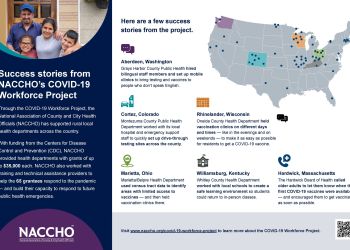 By JP Leider, Senior Lecturer at the University of Minnesota, Associate Faculty at the Johns Hopkins Bloomberg School of Public Health, and independent consultant based out of Minneapolis, MN
By JP Leider, Senior Lecturer at the University of Minnesota, Associate Faculty at the Johns Hopkins Bloomberg School of Public Health, and independent consultant based out of Minneapolis, MN
As NACCHO’s Profile Study returns to the field, I’ve decided to share a reminder of its importance to public health and thank practitioners.
The field of governmental public health is a complicated one. Between our state, local, territorial, and tribal health departments, there are something like 3,000 agencies devoted to the promotion and protection of population health. As someone who studies and works to support those organizations, large-scale datasets that enumerate their activities and characteristics are absolutely critical. I recognize big datasets don’t always sound like the most exciting things in the world. But these datasets, like NACCHO’s National Profile of Local Health Departments (Profile) Study, help us project workforce shortages, keep up with Electronic Health Record uptake at local health departments (LHDs), and figure out just how much the nation is spending on public health and whether it is worth it (spoiler: it is).
I consider the Profile Study one of the three tentpole research projects in our field. While the Profile Study tells us all about local and regional health departments, its corollary at the Association of State and Territorial Health Officials (ASTHO) tells us about the state health agencies. The third is relatively recent and only possible because of the first two. The Public Health Workforce Interests and Needs Survey (PH WINS) is a public health workforce survey with 47,000 respondents. Findings from the 2017 fielding are out at JPHMP now. The Profile Study was used (and needed) to be able to pull off such a large-scale effort.
What does NACCHO’s Profile Study let researchers and practitioners do?
- Figure out that over 50,000 jobs were lost in public health associated with the Great Recession
- Identify that hospital charitable spending is, unfortunately, largely unrelated to LHD activities in the jurisdiction
- Help us understand the benefits and barriers to public health accreditation
- Use GIS features to characterize profound rural disparities in the US at a public health systems level
- Look at how LHDs are often providers of last resort in their communities
- Understand the role information technology and electronic health records play in public health practice
- Identify how active LHDs are in policy work and the characteristics of those who are the most active
Personally, I’ve used the Profile Study in about 30 of the peer-reviewed articles I’ve written and published in the last decade. There is no other resource quite like it.
Its success depends on the largess of LHD staff themselves—in a time where folks are over-surveyed and overburdened, completing the Profile Study is a daunting task. But it’s critical! Without these data, our ability to provide education to policymakers and advocates diminishes greatly. Being able to say that over 2,000 LHDs across all 50 states responded to a survey identifying staffing, activities, and needs is incredibly powerful.
As the Profile Study goes back into the field over these next few months, a thanks to the practitioners doing the hard work—and a reminder to my research and pracademic colleagues to keep using these data.








